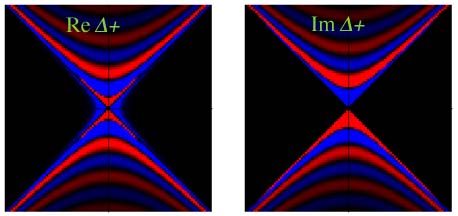
Instructor: Hitoshi Yamamoto
The goal of the course is to build up the basics of quantum field theory from the bottom up with as little cheating as possible. If you have solid understanding in quantum mechanics and special relativity, you should be able to follow this course without much difficulty assuming that reasonable amount of time and effort will be spent on the material. At the end of the course, I expect most of students to have a solid understanding of the field theory, and ability to calculate variety of simple processes.

Real and imaginary parts of Delta+(x) function. Blue is positive, red is negative, and black means zero. If the imaginary part is sign-flipped for t< 0, it becomes the Feynman propagator for spin-0 particle. The range plotted is -20 < t,x < 20 in unit of 1/m.
There will be a supplementary class on August 5 (Mon) at 1PM. The room is the same as the regular classes; namely 745. The final exam will be handed out then, but it will also be posted on web (this page).
Final exam is due on Aug 12 (Mon) at 5PM. final exam
The class is Mondays at 1PM Room 745.
Please print out your own copy of the lecture note and bring it to the class.
We will cover about ~20 pages in each class. (lecture notes will NOT be handed out in class)
Lecture notes are posted here. Print them out and bring the relevant section to the class.
Some tips:
Problem sets are handed out once a week in principle, due one week later at the beginning of the class, and graded problem sets are returned one week thereafter. Discussions among students on problem sets are encouraged.. I also welcome questions on problem sets even though I cannot tell you the answers directly (but such Q&A sessions are inevitably helpful in solving the problems). If problem sets are submitted after the corresponding solution sets are posted, then the score will be scaled by 1/2 to be fair with others who submitted in time.
Problem set 1, Problem 1.1, 1.2, handed out on Apr 19 (Fri) and due on Apr 22 (Mon). solution
Problem set 2, Exercises 1.3, 1.4, Problem 1.3, handed out on Apr 22 (Fri) and due on May 13 (Mon). solution
Problem set 3, Exercises 3.1, 3.2, 3.3, handed out on May 13 (Mon) and due on May 20 (Mon). solution
Problem set 4, Exercises 3.5, 3.6, handed out on May 20 (Mon) and due on May 27 (Mon). solution
Problem set 5, Exercises 3.7, 3.8, handed out on May 27 (Mon) and due on June 3 (Mon). solution
Problem set 6, Problems 3.3, 3.5, handed out on June 3 (Mon) and due on June 10 (Mon). solution
Problem set 7, Exercise 3.10, Problem 3.4, handed out on June 10 (Mon) and due on June 17 (Mon). solution
Problem set 8, Excercises 4.1, 4.2, handed out on June 17 (Mon) and due on June 24 (Mon). solution
Problem set 9, Excercises 4.3, 4.4, handed out on July 1 (Mon) and due on July 8 (Mon). solution
Problem set 10, Excercises 4.6, 4.7, handed out on July 8 (Mon) and due on July 29 (Mon). solution
Problem set 11, Excercises 4.10, 4.12, Problem 4.4, handed out on July 29 (Mon) and due on August 5 (Mon).
The course is based on lecture notes. The following, however, may be used as a main reference book:
'Introduction to Quantum Field Theory' by Peskin and Schroeder, Addison & Wesley, 1995.
Also check out other useful textbooks:
If you think you need more basics
,Grades are based on problem sets (homework) and the final exam. The final exam is take-home (namely, a 'report'); you can refer to any books or papers, but you have to do it on your own.
Accelerator facilities: